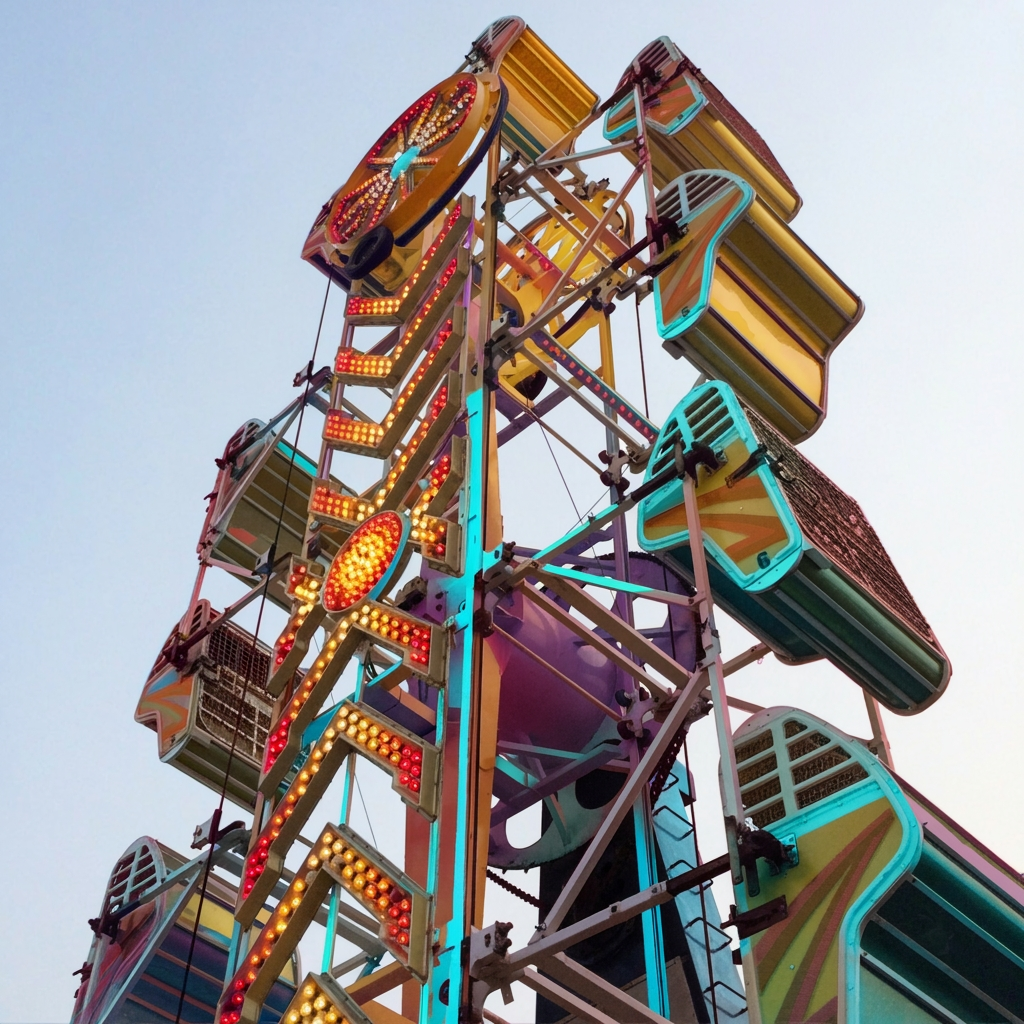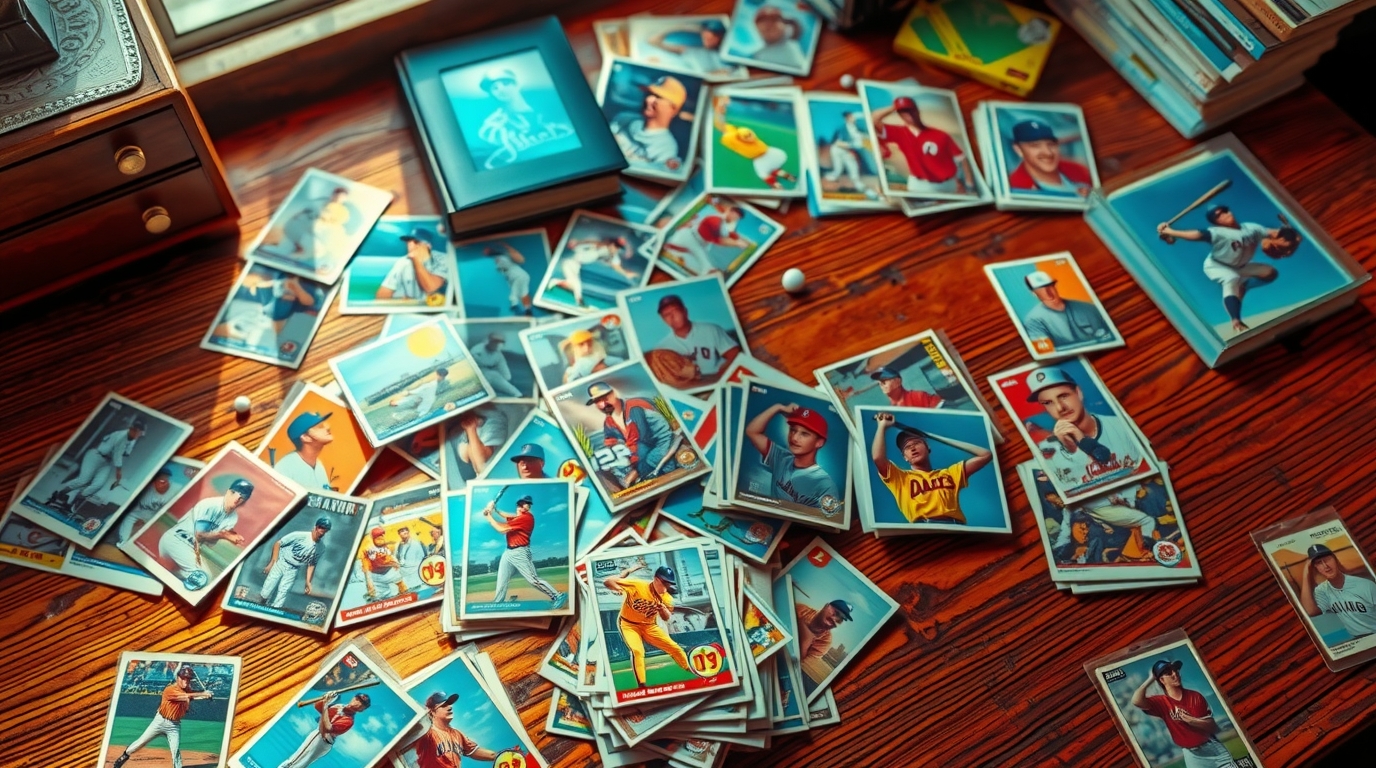Blast from the Past
Let’s Talk About the Zipper

The Ultimate Carnival Thrill Ride
Ah, the Zipper. Just saying the name is enough to trigger a flood of memories—some exhilarating, some nausea-inducing, and all of them tinged with that classic carnival magic. If you grew up in the ’80s or ’90s, there’s a good chance you either rode the Zipper at a local fair, chickened out at the last second, or watched in awe as your braver friends tumbled through the sky.
The Zipper wasn’t just a ride; it was a rite of passage. It separated the fearless from the faint of heart. It was that towering, whirling, metal beast covered in flashing lights, streaked with rust, and operated by a guy who looked like he might have put it together an hour ago. And yet, despite all logic and concern for bodily safety, we lined up year after year to experience the chaos.
The Mechanics of Mayhem
For the uninitiated (or those who have mercifully suppressed the experience), the Zipper is a towering, rotating oblong contraption featuring a moving boom with 12 to 14 enclosed cages attached to it. Each of these cages spins freely on its own axis, so as the main arm rotates, the individual cages also flip and tumble based on weight distribution and sheer physics-fueled terror. The result? A nonstop barrage of flips, spins, and stomach-churning motion.
Unlike some carnival rides that deliver predictable thrills, the Zipper was a complete wildcard. Depending on your weight, the balance of your riding partner, and a little luck (or misfortune), your cage could gently rock or become an out-of-control, vomit-inducing centrifuge.
The Zipper Experience: A Review from a Survivor
From the moment you stepped onto the ride platform, you knew you were in for something intense. First, the ride operator—often a man in a sleeveless shirt with a cigarette dangling from his lips—swung open the tiny metal door and gestured for you to cram yourself into the cramped cage. There was no dignified way to get in or out of a Zipper seat; it was always an awkward, clumsy shuffle followed by a too-tight shoulder bar locking into place.
Then came the worst part: the slow ascent while the ride loaded. The ride didn’t start all at once. Instead, the operator had to load each cage one by one, so there was always a moment where you’d be hanging at the very top, rocking slightly, staring down at the tiny people below and questioning every life choice that had led to this moment.
Then, with a horrible metallic groan, the boom started to rotate, and all hell broke loose. Some cages flipped in slow, eerie tumbles, while others (especially if you leaned forward just right) would enter full-blown chaos mode, spinning wildly as gravity took control. The most horrifying moment was when your cage got stuck upside-down for what felt like an eternity before physics decided to release you.
The whole experience lasted only a few minutes, but those minutes felt like an eternity of weightless terror, disorienting G-forces, and the occasional desperate scream. And yet, as soon as the ride slowed to a stop and you stumbled out onto solid ground, legs wobbly, head spinning, and stomach questionable, there was only one thing to say: “Let’s do it again.”
The Zipper’s Cultural Impact
Unlike sleek, modern roller coasters with meticulously engineered thrills, the Zipper was pure, unpredictable chaos. It was the ultimate test of bravery at county fairs, carnivals, and pop-up amusement parks. It was the kind of ride that separated the casual fairgoer from the true thrill-seeker.
And let’s be honest—half the fun of the Zipper was the spectacle. Watching from the ground was just as entertaining as riding. You’d see riders laughing, screaming, or regretting their choices in real-time. Sometimes a lone shoe would fly out of a cage. Sometimes someone would yell, “I hate this!” loud enough for the whole crowd to hear. And sometimes, just sometimes, the ride would have to be briefly shut down for… unsanitary reasons.
Where Can You Still Find the Zipper Today?
If you’re feeling nostalgic and want to take another spin (or see if you can still handle it as an adult without losing your lunch), you’re in luck. While many classic carnival rides have been retired or replaced, the Zipper has endured.
You can still find Zipper rides operating at traveling carnivals and state fairs across the U.S. Companies like Butler Amusements and North American Midway Entertainment still haul these beasts from town to town, offering a fresh generation the chance to experience its unique brand of terror. Some permanent amusement parks, particularly those with old-school carnival sections, still feature a Zipper among their lineup of classic rides.
For those seeking the most authentic, nostalgia-drenched Zipper experience, the best bet is to check out county fairs, regional amusement events, or old-school traveling carnivals. It’s a little less common than it was in its heyday, but it hasn’t vanished just yet. And honestly, the fact that it still exists at all is a testament to its legendary status.
Blast from the Past
The Lost Art of the ’90s Mix CD

Long before Spotify playlists and algorithm-driven “Discover Weekly” mixes, there was the mix CD—a shiny, handcrafted token of your musical taste and emotional state. For ’90s kids and early 2000s teens, burning a CD wasn’t just about copying songs onto a disc. It was a sacred ritual, a labor of love, and sometimes, a dramatic cry for attention.
The mix CD was the love letter, the party starter, the breakup soundtrack, and the ultimate road trip companion. It told a story, track by track, carefully sequenced to deliver just the right emotional arc. And if you were lucky enough to receive one? That was basically the equivalent of someone handing you their heart on an 80-minute platter.
Let’s rewind and celebrate the lost art of the ’90s mix CD—and why we secretly miss it.
1. Crafting the Perfect Playlist (Before It Was Easy)
Today, you can drag and drop songs into a playlist in seconds. But in the ’90s, burning a CD meant curation with purpose. You had 700 MB of space (or about 18-20 songs if you were sticking to standard audio format). Every track counted.
There were no “shuffle” options—your tracklist was your narrative. You had to think about the opening song (it needed to hook the listener), the pacing, the build-up, the emotional peaks, and the perfect closer. Did you end on a soft ballad to leave them in their feelings, or on a high-energy banger to make them hit repeat?
Making a mix CD wasn’t passive. It required intent, creativity, and a little soul-searching.
2. The Drama of LimeWire, Napster, and Sketchy Downloads
Getting the songs for your mix wasn’t always as easy as pulling up a digital library. In the late ’90s and early 2000s, you were often at the mercy of Napster, LimeWire, Kazaa, or whatever shady file-sharing service your dial-up connection could tolerate.
Every download was a gamble: Would you get the full song? Would it randomly cut off at 1:42? Did you accidentally download a weird live version with audience screams drowning out the vocals?
And let’s not even talk about computer viruses, and how many of those we downloaded on accident…
3. The Handwritten Tracklist: A Window Into Your Soul
Sure, the mix itself was important—but the presentation was just as crucial. The handwritten tracklist on the inside of the jewel case or scribbled across the CD-R itself? That was where the magic lived.
Would you go with block letters? Bubble letters? Color-coded pens? Maybe throw in a doodle of a broken heart or some stars? The effort you put into the cover art and tracklist was a direct reflection of how much you cared (or how much you wanted to look like you didn’t care).
Bonus points if you titled the mix something poetic like “Summer Nights ’99” or “Songs for When You’re Not Around.” Maximum drama.
4. The Unspoken Messages Hidden in the Mix
Mix CDs were often love letters in disguise. Every song choice could feel like a secret message. Were you telling your crush that a song reminded you of them? Did including a specific song relay the message that you were in love? That you were confused? That you were pissed?
The sequencing itself was part of the message. Slotting “I Want You to Want Me” right after “Friends Forever” wasn’t accidental—it was a carefully calculated emotional rollercoaster.
You could say things with a mix CD that you were too chicken to say out loud. It was teenage vulnerability burned onto a disc.
5. The Risk and Reward of Gifting a Mix CD
Giving someone a mix CD was a bold move. You were putting your tastes and feelings out there for judgment. Would they listen to it on repeat and fall madly in love with you—or toss it into the glove compartment and forget it existed?
Even worse: Would they think your song choices were cringe? Did they think you were nuts?
But when it worked? When your mix hit just right and they actually got it? That feeling was unbeatable.
6. The Joy of Listening Front to Back
Unlike playlists today that often get shuffled, a good mix CD was designed to be listened to from start to finish. Each song led to the next, creating a vibe, a journey. There was anticipation: You knew what was coming after that third track, and the transition felt just right.
This sequencing made certain song pairings iconic in your mind. To this day, hearing “Bittersweet Symphony” might still remind you of whatever song you slotted right after it on your “End of Summer ’98” mix.
Final Thoughts
The mix CD was the spiritual successor to the mixtape, but it came with the power of digital precision. It lived in that perfect moment between analog and digital, between effort and technology. Making one wasn’t about hitting “shuffle” or asking an AI to recommend songs—it was about pouring your heart, your taste, and your creativity into 80 minutes of sonic storytelling.
So here’s to the lost art of the ’90s mix CD. May your old burned discs still spin, and may we never forget the feeling of holding someone’s emotions in a jewel case labeled “For You.”
Oh, and if you still have one of your old mixes? Go ahead—pop it into a dusty CD player you have chilling in the garage (if it still works). Those feels still hit hard.
Blast from the Past
Licking the Cold Metal Pole – The Ultimate Double Doggy Dare
Who else put their pocket money on the line?

Does Licking the Rusty Pole at School Really Make Your Tongue Stick?
We all knew that kid. The one who, on a dare, pressed their tongue to the cold, rusted metal pole on the playground in the dead of winter. The result? Panic, screaming, and an unfortunate trip to the nurse’s office (or worse, a teacher with a cup of warm water). But was it really an urban legend? Or was there actual science behind the whole frozen-tongue fiasco?
Let’s break it down and finally settle the mystery of whether licking a rusty, frozen pole really makes your tongue stick—and why.
The Science of Sticking
The short answer? Yes. Licking a cold metal pole under the right conditions will cause your tongue to stick. And there’s a pretty simple scientific reason behind it.
Metal is an excellent conductor of heat, meaning it quickly absorbs warmth from whatever touches it—including your tongue. In frigid temperatures, metal gets so cold that it can instantly freeze any moisture that comes into contact with it. Your tongue, being nice and damp, makes the perfect candidate for this science experiment gone wrong.
When you lick the pole, the saliva on your tongue freezes almost instantly, creating a bond between your tongue and the metal. The result? You’re stuck, and no amount of panicked yanking is going to set you free easily. If you pull too hard, you risk leaving behind a bit of skin (ouch), and let’s be honest, nobody wants to be that person.
But What About Rust?
Now, if you grew up in the ‘80s or ‘90s, chances are the poles on your school playground weren’t just cold—they were rusty too. So, did rust make it more or less likely that your tongue would stick?
Rust itself doesn’t change the science of freezing, but it does make the experience even grosser. Rust is simply iron oxide, and while small amounts of it aren’t necessarily dangerous, it’s definitely not something you want in your mouth. Plus, rusty surfaces tend to be rough and uneven, which means they might actually increase the contact points between your tongue and the metal, making the bond even stronger. In other words, licking a rusty pole might not only get you stuck—it might get you really stuck.
Did Every Kid Try This?
While it might not have happened to everyone firsthand, everyone knew someone who got their tongue stuck. The story is so widespread that it even made its way into pop culture, most famously in A Christmas Story, where poor Flick learns the hard way that double-dog dares should never be taken lightly.
Even though we all heard the warnings, there was always that one kid who had to test it out. Maybe it was curiosity, maybe it was peer pressure, or maybe it was just the undying need to see if what our older siblings told us was true.
The Verdict: Myth or Fact?
Fact. It turns out, this was one of the few schoolyard myths that was completely real. Freezing temperatures, metal poles, and a curious tongue equal instant regret. So, if you ever get the urge to test this old playground legend as an adult (hey, no judgment), just remember—you now have the wisdom to avoid that particular mistake.
And if you did fall victim to the frozen pole in your youth, wear it as a badge of honor. You were part of an exclusive club of kids who learned an unforgettable lesson in physics… the hard way.
Blast from the Past
Where Have All the Baseball Cards Gone?

The Rise and Fall of Baseball Cards: From Treasure to Tragedy
There was a time when baseball cards weren’t just pieces of cardboard—they were currency, status symbols, and tiny portals into the world of America’s pastime. If you grew up in the ’80s or early ’90s, you probably remember the thrill of tearing open a fresh wax pack, the intoxicating scent of cheap gum, and the hope that you might find a Ken Griffey Jr. rookie card or a Don Mattingly gem hidden inside.
But somewhere along the way, the baseball card industry went from a booming phenomenon to an overproduced cautionary tale. Today, most of those once-prized collections are gathering dust in attics, their values nowhere near the goldmine we all once imagined. So what happened? How did baseball cards go from playground gold to nearly worthless relics of a bygone era? Let’s take a trip down memory lane—and examine where it all went wrong.
The Golden Age of Baseball Cards
In the early-to-mid 20th century, baseball cards were an essential part of childhood. Kids collected them, traded them, and even stuck them in bicycle spokes for that satisfying “motor” sound. Cards from the ’50s and ’60s—like the legendary 1952 Topps Mickey Mantle—became some of the most valuable collectibles of all time, setting the stage for what would later become a full-blown card craze.
By the 1980s, the hobby had evolved into something bigger. Topps, Fleer, and Donruss were producing high-quality sets, and by the late ’80s, Upper Deck entered the scene, introducing premium cards with sharp photography and holograms. Card shops popped up everywhere, and suddenly, collecting wasn’t just for kids—it was an investment.
The media and magazines hyped up certain cards as “must-haves,” fueling a new wave of collectors who saw dollar signs instead of childhood joy. People started hoarding unopened boxes, convinced that these little rectangles of cardboard were their ticket to early retirement. And then… the bubble burst.
The Overproduction Era: A Cardboard Catastrophe
By the early ’90s, baseball card companies saw the demand and did what any business would do: they flooded the market. Millions of cards were printed. Then tens of millions. Then hundreds of millions. Every kid with a shoebox full of cards thought they were sitting on a fortune, but the reality was far less glamorous—when supply outweighs demand, value plummets.
This period—known as the “junk wax era”—saw an explosion of mass-produced, low-value cards that are now worth little more than their nostalgic appeal. Collectors who had hoarded boxes expecting them to appreciate in value were left with stacks of worthless cardboard.
And it wasn’t just overproduction that hurt the industry. By the mid-to-late ’90s, baseball itself was suffering. The 1994 strike, followed by steroid scandals, chipped away at the sport’s integrity, and as interest in baseball waned, so did interest in collecting its cards.
The Modern Resurgence—And Why It’s Not the Same
Fast-forward to today, and you might hear whispers about a resurgence in the card-collecting hobby. But while there has been renewed interest—especially in high-end, limited-run cards—the nature of the market has changed.
Companies like Topps and Panini have embraced a new strategy: exclusivity. Instead of mass-producing millions of identical cards, they now release short-print, limited-edition cards, often autographed or featuring jersey swatches. This keeps values high, but it’s also made the hobby less accessible.
Whereas kids once bought packs for pocket change, today’s “chase” cards are often locked behind expensive boxes that can cost hundreds of dollars. The fun of ripping open a pack and hoping for a legendary pull has been replaced by a business-driven, speculative market that caters more to deep-pocketed collectors than to everyday fans.
The Legacy of Baseball Cards
Despite the decline of the casual collecting culture, baseball cards still hold a special place in our memories. Even if those shoeboxes of junk wax aren’t worth much, they represent something priceless: a time when the simple joy of finding your favorite player’s card was more important than its value.
Maybe the lesson here is that collectibles should be about passion, not profit. The real treasure wasn’t in the investment—it was in the experience. And maybe, just maybe, that’s why we still hold onto them in our memories, even when we know they never did manage to make us rich.
-

 Let's Settle It1 month ago
Let's Settle It1 month agoTop 10 Cheat Codes That Would Be Awesome in Real Life
-

 Blast from the Past1 month ago
Blast from the Past1 month agoRemembering the Perfect Friday Night: Pizza and the Video Stores in the 90s
-

 Blast from the Past1 month ago
Blast from the Past1 month agoLicking the Cold Metal Pole – The Ultimate Double Doggy Dare
-

 Blast from the Past1 month ago
Blast from the Past1 month agoWhere Have All the Baseball Cards Gone?
-

 Blast from the Past1 month ago
Blast from the Past1 month ago10 Toys from the ’80s and ’90s That Would Never Be Allowed Today
-

 Dollhouse Diaries1 day ago
Dollhouse Diaries1 day agoHow ’90s Mall Culture Shaped a Generation of Girls
-

 High Score1 day ago
High Score1 day agoTop 10 School Lunch Items from the ’90s (and their trade value) That Made Lunchtime Legendary
-

 Blast from the Past1 day ago
Blast from the Past1 day agoThe Lost Art of the ’90s Mix CD




